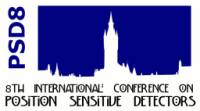Speaker
Prof.
Harry van der Graaf
Description
100 years ago, in Manchester, Hans Geiger operated the first gaseous
detector, which was the basis for 'wire chambers', widely applied as
track imaging in particle physics experiments.
In wire chambers gas amplification occurs, close to the wire surface,
due to he strong (1/R) electric field. This enables the detection of the
few single electrons created in the gas by ionisation radiation.
In Micro Pattern Gas Detectors, areas with a strong electric avalanche
field are created by one or more conductive perforated planes (grid).
The granularity of such a detector is determined by the hole pitch and
can be much better in comparison to wire chambers.
With each grid hole equipped with its own readout channel (preamp,
shaper, discriminator) in the form of an active pixel array in a CMOS
chip, this micro-granularity is pursued: each hole is a stand-alone
detector. This matches future demands on occupancy, position resolution
and time resolution for high radiation trackers at future ILC, CLIC or
sLHC colliders.
Chip manufacturing processes made two innovations possible: the
integration of Micro Pattern Gas Detectors with pixels chips (Integrated
Grid, InGrid), and the deposit of a high-resistivity protection layer on
top of pixel chips. This 'wafer post processing' technology may enable
next innovations such as micro channel plates and secondary emission foils.
Essentially, the application of gas as detection material, compared to,
for instance, Si, offers several advantages, relevant for future
tracking and imaging detector developments. For this, the development of
TimePix-2, a new general-purpose pixel chip, is essential.
Author
Prof.
Harry van der Graaf

